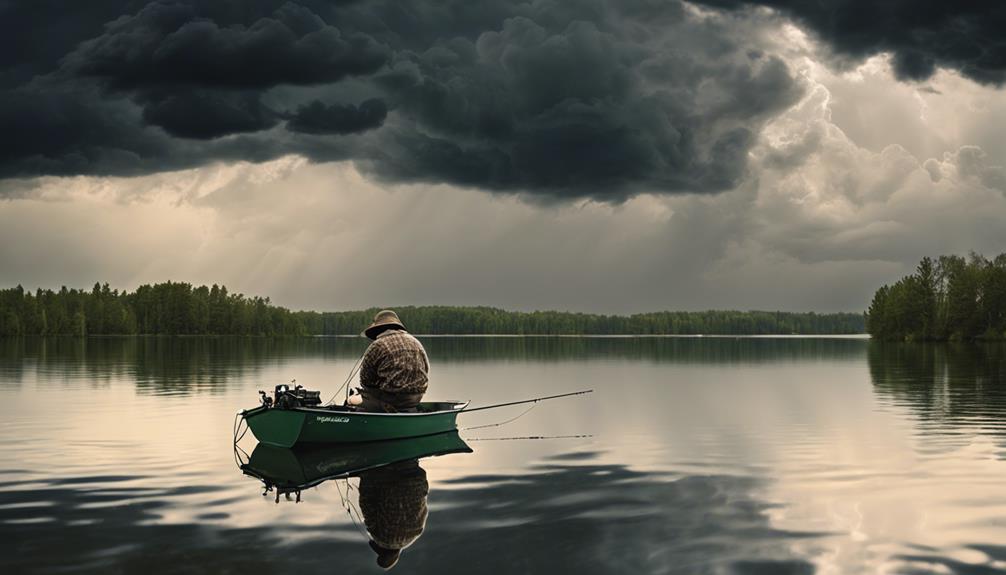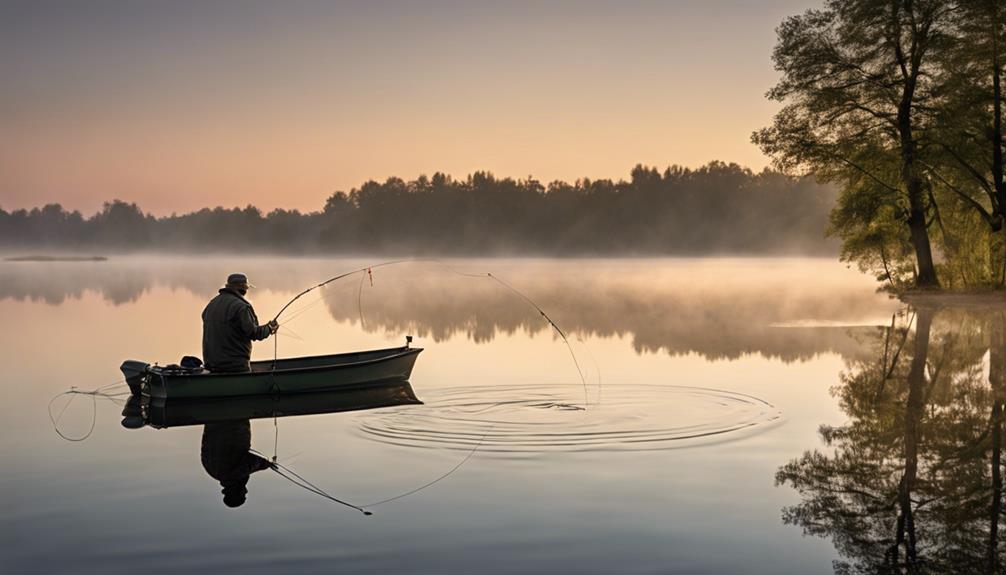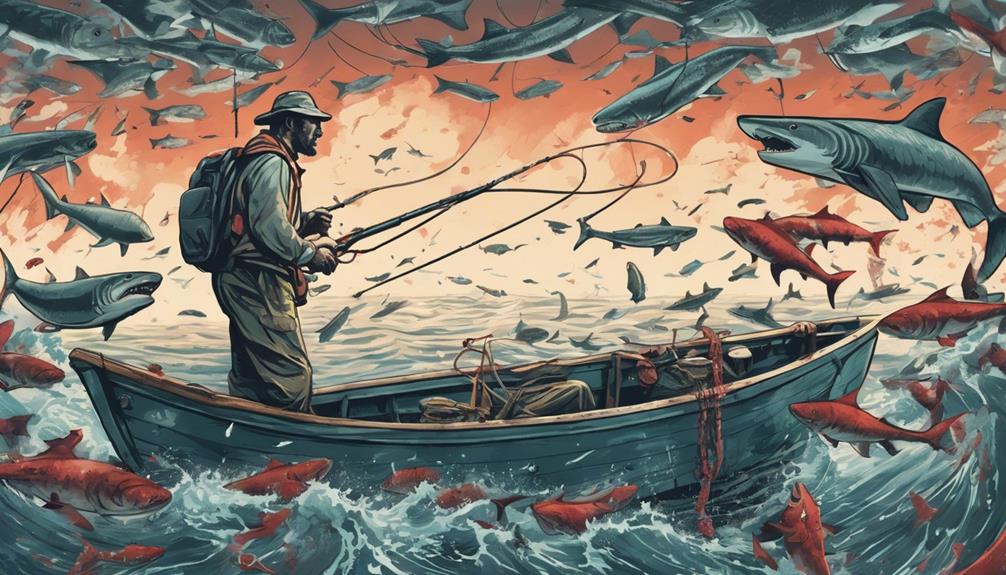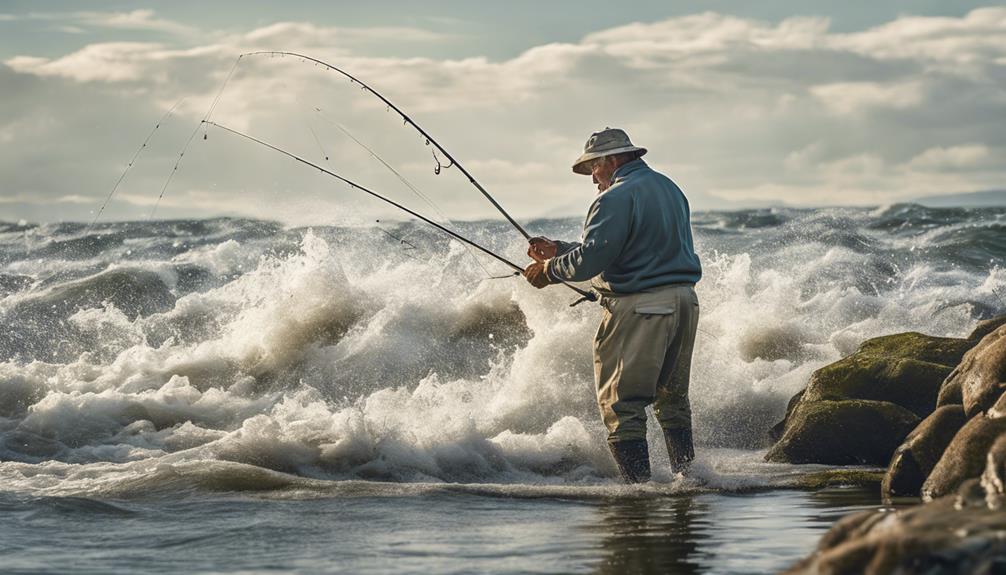Imagine the tranquility of a mist-covered lake at dawn, the only sound the gentle lapping of water against your boat. As you prepare to pursue the elusive northern pike, mastering these 9 effective techniques can make all the difference in your success on the water.
From understanding their behavior to selecting the right gear, each aspect plays a crucial role in your pike fishing adventure. Stay tuned to discover how each technique can elevate your angling game and lead you to that prized northern pike catch.
Understanding Northern Pike Behavior
To successfully catch northern pike, it's essential to understand their behavior patterns. Northern pike have specific prey preferences, favoring fish such as perch, walleye, and minnows. Knowing their prey choices can help you select the appropriate lures or bait to attract them effectively. These predatory fish are often found in a variety of natural habitats, including weed beds, rocky areas, and near drop-offs. During different seasons, northern pike exhibit varying feeding habits. Understanding these seasonal patterns is crucial for successful fishing expeditions.
In the spring, northern pike are typically more active as they recover from the winter months. They tend to move to shallower waters to feed on spawning fish and take advantage of the increased activity in these areas. As the weather warms up, their metabolism rises, leading to more aggressive feeding behavior. During the summer months, northern pike may retreat to deeper, cooler waters where they're more sluggish and less likely to actively pursue prey. This behavior shifts again in the fall as they prepare for the winter months by feeding voraciously to store energy.
Selecting the Right Gear
When gearing up for northern pike fishing, choose your equipment based on the specific habits and habitats of these predatory fish. Northern pike are known for their aggressive nature and sharp teeth, so it's essential to select gear that can withstand their strength. Make sure to maintain your gear regularly to ensure it functions optimally when you're out on the water. Proper storage is also crucial to prevent damage and corrosion, especially for items like reels and lures.
Customizing your gear can give you an edge when targeting northern pike. Consider DIY modifications such as adding stronger hooks or increasing the weight of your lures to reach deeper waters where these fish often lurk. By tailoring your gear to suit the behavior of northern pike, you can increase your chances of a successful fishing trip.
When selecting rods and reels, opt for sturdy options that can handle the fight these powerful fish put up. Spool your reel with a strong, abrasion-resistant line to prevent snapping when a pike strikes. Additionally, using leaders made of steel or fluorocarbon can prevent bite-offs from their sharp teeth. Remember, choosing the right gear is key to a successful northern pike fishing expedition.
Mastering the Art of Casting
Master your casting technique to effectively target northern pike with precision and accuracy. To lure in the elusive northern pike successfully, honing your casting skills is crucial. Here are some key tips to help you improve your casting game:
- Focus on Casting Accuracy, Distance: When aiming for northern pike, precision is key. Practice casting accurately to specific spots where pike are likely to hide, such as near weed beds or rocky areas. Additionally, work on increasing your casting distance to cover more water and reach those hard-to-reach spots where big pike might be lurking.
- Master Line Control: Northern pike are known for their aggressive strikes, and having good line control is essential to handle their powerful runs. Practice controlling the line during casting to ensure a smooth and accurate presentation of your bait or lure. This skill will also help you set the hook effectively when a pike bites.
- Employ Finesse Techniques: While northern pike are predators, they can also be quite wary. Use finesse in your casting approach by making subtle movements and presentations to entice these cunning fish. Avoid making loud splashes or abrupt movements that could scare them away, and instead, opt for a more delicate and strategic casting style.
Utilizing Live Bait Strategically
Utilize live bait strategically to entice northern pike effectively and increase your chances of a successful catch. When using live bait, such as minnows or suckers, proper bait presentation is crucial. Make sure your bait looks natural and lively in the water to attract the pike. Consider the size of the live bait; it should be large enough to entice the pike but not too big that it deters them.
Hook placement is another critical aspect when using live bait. Place the hook in a way that allows the bait to move freely in the water, mimicking the natural movement of prey. This increases the chances of a pike striking your bait. Be mindful of the size of the hook; it should match the size of the live bait to ensure a secure hookset when the pike bites.
While live bait can be highly effective, don't underestimate the power of artificial lures. Lures can be used strategically to cover more water efficiently and locate active pike. Experiment with different types of lures, such as spoons, spinners, or jerkbaits, to find what works best in your fishing location. By alternating between live bait and artificial lures based on the conditions and pike behavior, you can maximize your chances of a successful northern pike fishing trip.
Perfecting the Retrieval Technique
To enhance your success in catching northern pike, mastering the retrieval technique is essential. When perfecting your retrieval technique, consider the following tips:
- Speed Variations: Experiment with different retrieval speeds to find what entices the northern pike. Sometimes a fast retrieve can trigger a strike, while other times a slow and steady approach is more effective. Varying the speed can mimic an injured fish, making it irresistible to these predators.
- Precision Control: Practice controlling the depth at which your lure moves through the water. Northern pike are known to lurk at different depths depending on various factors like water temperature and time of day. Being able to adjust your lure's depth with precision can significantly increase your chances of attracting a strike.
- Lure Placement: Pay attention to where you cast your lure. Northern pike are ambush predators and often hide near structures like weed beds, fallen trees, or rocky outcrops. By placing your lure strategically near these areas, you can increase the likelihood of enticing a pike to strike. Adjust your casting technique to ensure your lure lands in the most promising locations.
Mastering the retrieval technique by incorporating speed variations, precision control, and strategic lure placement will undoubtedly improve your chances of hooking more northern pike.
Exploring Topwater Lure Tactics
When exploring topwater lure tactics for northern pike fishing, consider the impact of surface disturbances on enticing strikes. To lure these aggressive predators, try nighttime strategies for a stealth approach. Northern pike are known to be more active during low light conditions, making it an opportune time to target them with topwater lures. As you cast your lure across the water's surface, focus on creating subtle movements to mimic injured baitfish. This stealthy approach can trigger explosive surface strikes that will get your heart pounding with excitement.
Using topwater lures during dawn or dusk can also be effective as pike tend to be more active during these times. The key is to reel in your lure slowly, allowing it to create enticing ripples and splashes on the surface. This technique mimics a wounded or struggling prey, making it irresistible to hungry pike lurking below. Keep your movements deliberate yet erratic to simulate a distressed baitfish, increasing your chances of triggering surface explosions from these ambush predators.
Remember to vary your retrieval speed and cadence to determine what triggers the most strikes. Observing how pike react to different topwater presentations will help you fine-tune your tactics for maximum success. So, next time you head out for northern pike fishing, equip yourself with topwater lures and get ready for heart-pounding surface action.
Adapting to Changing Weather Conditions

In response to shifting weather patterns, adjust your fishing approach accordingly for optimal results. When facing changing conditions, your ability to adapt is crucial for maximizing your fishing success.
Here are some key weather adjustments and adaptation strategies to consider:
- Monitor Weather Forecasts: Stay informed about upcoming weather changes to plan your fishing trips effectively. Adjust your fishing schedule based on predicted conditions to increase your chances of success.
- Experiment with Different Baits: Changing weather can influence the pike's feeding behavior. Be prepared to switch between various bait types such as spinners, spoons, or live bait to entice bites in different weather conditions.
- Explore Different Depths: Pike may change their positioning in the water column based on weather patterns. In response, try fishing at various depths to locate where the pike are actively feeding. Use this information to your advantage when adapting to fluctuating weather conditions.
Practicing Proper Catch and Release
Practicing proper catch and release techniques is essential for maintaining the health and sustainability of northern pike populations. Conservation awareness plays a crucial role in preserving the delicate balance of aquatic ecosystems. When engaging in ethical angling practices, it's important to handle the fish with care to minimize stress and maximize their chances of survival after release.
Effective fish handling is a cornerstone of wildlife preservation. When catching northern pike, always use barbless hooks to minimize injury. Keep the fish in the water as much as possible and avoid excessive handling. If you need to handle the pike, make sure your hands are wet to protect their delicate slime layer. Support the fish horizontally to avoid damaging their internal organs, especially with larger specimens.
Frequently Asked Questions
Can You Use Artificial Lures for Northern Pike Fishing, or Is Live Bait Always Necessary?
When fishing for northern pike, you can definitely use artificial lures. While live bait is effective, artificial lures can also be successful. Pike are known to strike at various artificial lures such as spoons, spinners, and jerkbaits.
Experiment with different techniques and lure types to see what works best in different fishing locations. Identifying structures where pike like to hide can also increase your chances of a successful catch using artificial lures.
Are There Any Specific Locations or Structures in a Lake or River Where Northern Pike Are More Likely to Be Found?
In lakes or rivers, Northern Pike are often found near specific locations or structures. They tend to hang around depth variations, such as drop-offs, and hide in weed beds.
Keep an eye out for underwater structures like fallen trees or rock formations, where these predatory fish like to lurk. Understanding current patterns can also help you locate where Northern Pike might be hiding and increase your chances of a successful fishing excursion.
How Do You Handle Northern Pike Safely to Avoid Injury to Both Yourself and the Fish?
When handling northern pike, make sure to use proper techniques to avoid injuries to both yourself and the fish.
It's important to support the fish's body properly and avoid touching their gills.
Remember to wet your hands before handling them to protect their slime layer.
When releasing a pike, gently lower it back into the water and allow it to swim away on its own.
Practicing good catch-and-release methods is essential for conservation.
Is There a Certain Time of Day That Is Best for Northern Pike Fishing, or Is It Just a Matter of Preference?
When it comes to northern pike fishing, the best time for success can depend on whether it's morning or evening. Both times have their advantages, so it's really up to your preference.
Keep in mind that weather conditions play a big role too. Factors like temperature and cloud cover can impact your fishing success. So, whether you choose to fish in the morning or evening, be sure to consider the weather for the best chance at catching some northern pike.
What Are Some Common Mistakes That Beginner Anglers Make When Fishing for Northern Pike, and How Can They Be Avoided?
When fishing for northern pike, beginners often make mistakes with their equipment choices and lack of patience. To avoid these errors, ensure you have the proper gear, like strong rods and lines.
Stay patient and persistent, as pike can be elusive. By being prepared with the right equipment and maintaining patience, you can improve your chances of a successful catch.
Conclusion
Now that you have learned these 9 effective techniques for northern pike fishing, you're well-equipped to reel in some impressive catches.
Remember to always understand the behavior of the fish, select the right gear, and master your casting and retrieval techniques.
Utilize live bait strategically and explore different lure tactics.
Adapt to changing weather conditions and practice proper catch and release to ensure the sustainability of this exciting sport.
Happy fishing!



